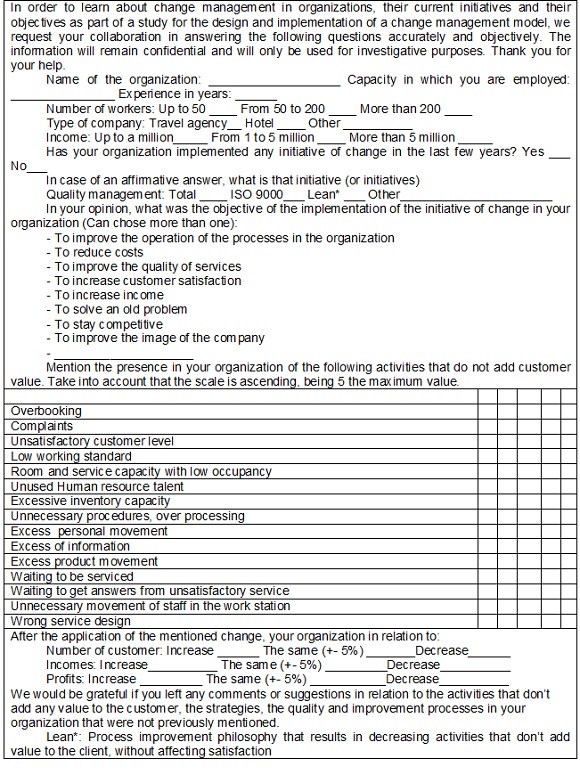
___________________________________________________________________________________________________________________
Visión de futuro
REVISTA CIENTIFICA
ISSN 1668 - 8708 VERSION EN LINEA
URL DE LA REVISTA: http://visiondefuturo.fce.unam.edu.ar/index.php/visiondefuturo/index
E-mail: revistacientifica@fce.unam.edu.ar
___________________________________________________________________________________________________________________
AÑO 17, VOLUMEN 24 N° 1, ENERO - JUNIO 2020
URL DEL DOCUMENTO: http://visiondefuturo.fce.unam.edu.ar/index.php/visiondefuturo/issue/view/17
Los trabajos publicados en esta revista están bajo la licencia Creative Commons Atribución-NoComercial 2.5 Argentina
FACTORS THAT LIMIT CUSTOMER VALUE IN TOURISTIC FACILITIES, AS PERCEIVED BY MANAGERS AND SPECIALISTS
Carlos Ernesto Zambrano Cancañón; Yosvani Orlando Lao León; Maira Rosario Moreno Pino _______________________________________________________________________________________________________________________________
Factors that limit customer value in touristic facilities, as perceived by managers and specialists
(*) Carlos Ernesto Zambrano Cancañón; (**) Yosvani Orlando Lao León; (***) Maira Rosario Moreno Pino
(*) Faculty of Economics and Business Administration, Holguín University
Holguín-Cuba
zambrano@uho.edu.cu
(**) Faculty of Mathematics and informatics
Holguín University
Holguín- Cuba
ylaol@uho.edu.cu
(***) Faculty of Economics and Business Administration
Holguín University
Holguín- Cuba
mmoreno@uho.edu.cu
Reception Date: 06/10/2019 – Approval Date: 09/25/2019
ABSTRACT
Due to the increased change rate and high competitiveness of today’s world market, it is of the utmost importance to identify the non-value activities in every organization. This research analysis on organizational change management covers between 2017 and 2018 in sixteen touristic facilities of the Holguín territory, in Cuba. Its main objectives were to verify whether waste occurs and to analyze the main changes that took place in these entities. The methods used in order to conduct this research were: theoretical methods, such as synthesis and analysis and inductive-deductive; empiric methods, such as surveys and statistic methods, such as factor analysis. The main conclusion of the research was that waste occurs in all of the facilities that were included in the research. This waste can be grouped according to five factors, of which the most significant one is waiting time. The research also shows that the main change-driving initiatives taking place are linked to the implementation of a comprehensive quality control system and to cost reduction, and that the objectives of these initiatives are to increase incomes, to reduce costs and to boost customer satisfaction.
KEY WORDS: Waste; Organizational Change; Customer Value; Total Quality; Lean.
INTRODUCTION
Due to the competitive and dynamic character of the environment in which scholars specialized in management and other disciplines work, they have investigated into the reasons for change in an organization (Van de Ven & Poole, 1995). This environment accounts for an increasing interest in the study of organizational change, given the need to implement certain changes in mid and long-term strategies, specifically in the services sector and particularly in tourism(Espino Valdés, 2014; Higham & Miller, 2018; Osei & Chen, 2018; Pérez Vallejo, 2016). According to The Machine that Changed de World (Womack, Jones, & Roos, 1990), which popularized lean around the world. The term waste has several meanings in the scientific communities (Bicheno & Holweg, 2000; Burgess & Radnor, 2013; Womack & Jones, 1996), The authors of this research consider that detecting wastes is the first step towards the implementation of the lean philosophy, but not its essence, an opinion that matches that of several authors (Burgess & Radnor, 2013; Carlborg, Kindström, & Kowalkowski, 2013; Hines, Taylor, & Walsh, 2018; Pearce & Pons, 2017). Lean is to move into an uninterrupted flow of operations that guarantees superior quality, which requires continuous improvement in three dimensions: waste reduction, increased value and people involvement. It is a series of tools that, based in the constant elimination of wastes, serve the purpose of increasing competitivity (Shah & Ward, 2007). Initially, waste reduction was the essence of the lean philosophy and the base for the Toyota Production System (TPS) (Ohno, 1988; Shingo & Dillon, 1989). This research adapts its precepts to the tourism sector. Levitt (1972) states that there is not such a thing as a service industry, but industries with a lower or higher service component. The analysis of waste in the service industry features in works from Bowen and Youngdahl (1998) ) to more recent studies (Dos, Leite, & Vieira, 2015; Pearce & Pons, 2017; Smith, Paton, & MacBryde, 2018; Tenório, de Assis, da Silva, de Paula Ferreira, & Tanaka, 2018; Vlachos, 2015; Womack & Jones, 2005). Tourism in Cuba has notably influenced technological, economic and sociocultural changes, and in the last few decades has become an important alternative for development (Browne, 2014). It is estimated that in Holguín there will be a gradual increase of 19000 rooms from 2017 to 2025, with Gibara, downtown Holguín and Ramón de Antillas being the main focus of this increase (MINTUR, 2016). Investigations performed by Vilariño Corella (2012) concluded that only between 40 and 70% of the businesses located in Holguin have implemented initiatives of organizational change. Furthermore, according to ONEI (2017), the hotels in Holguín are potentially able to increase the amount of guests they receive. The value is the way a client measures the response to his expectations. It is a balance between the quality or the perks perceived in a product and the effort necessary to acquire the price to pay for said product (Zeithaml, 1984). The perceived value of a service is the judgement a client makes of a service, where all the benefits and sacrifices perceived regarding the service are processed simultaneously in the mind of the client, which results in a global evaluation of the provider of the service (Kotler & Armstrong, 2010). Therefore, as the activities that report no value are eliminated, the client will gain satisfaction by having to pay less or by receiving a response that fulfills his expectations. Papers that link wastes and value in Tourism directly were not found in the scientific literature reviewed. Lean thinking has been applied to tourism (Rauch, Matt, & Linder, 2018; Vlachos & Bogdanovic, 2013). In this empirical investigation, the pertinence and necessity of its application to the tertiary sector becomes evident. This article aims to prove the existence of wastes in the service industry from managers and specialist’s perspective in travel agencies and hotels. To evidence the possibility of identifying wastes from the management perspective as the first step for the introduction of lean philosophy was a problem to solve. How should wastes be grouped inside the hospitality industry? Is there waste in the facilities involved? What are the main initiatives of the changes taking place in touristic facilities? What are the main objectives of the changes taking place in touristic facilities? Is it advisable to apply lean philosophy in tourism?
DEVELOPMENT
Wastes
By studying independently the different processes necessary for tourism activities and the wastes they can generate, several articles were found regarding overbooking (Sierag, Koole, van der Mei, van der Rest, & Zwart, 2015), quality deficiencies (Agus, Barker, & Kandampully, 2007) , inventory and processes (Pérez Campaña, 2005; Pérez Pravia, 2010) , transportation (Spasojevic, Lohmann, & Scott, 2018), waiting time (Maskivker, 2015), and several that analyze the organization of workforce, but without going deeper into any of these subjects. Among the investigations analyzed there were researches on wastes related to the environment (Tomazzoní & Correa, 2013), in a hotel (Silva Pereira & De Conto, 2008), and in a tourism event (De Conto et al., 2011), from the perspective of the clients. An investigation on the seven wastes in tourism was accessed, these are concentrated on the reservation and supplying process and its link with techniques (Vlachos & Bogdanovic, 2013), however, the authors of this investigation only agree on five of them. Wastes in tourism, without making particular distinctions from those identified in manufacture, are classified as: those related to production and/or overbooking, which refer to the sale of hotel rooms or services beyond the actual availability of these, and occur due to the practice of over-selling in order to maximize earnings. The analysis and comparison of overbooking and under-booking costs in order to prevent them, as well as their relation to unnecessary inventories of rooms (Aydin & Birbil, 2018) , products, work force and services is an aspect that requires constant study, also classified as waste.
When the client does not receive the services or responses when requested (waiting time), they usually perceive it as wasted time, causing irritation, uneasiness and frustration (Maskivker, 2015), this problem has been identified by most authors, but few among them have studied its impact in utilities (De Vries, Roy, & De Koster, 2018). These authors agree that clients usually associate waiting time with deficiency of the service, quality problems and low standards, which can cause reprocesses, an increase of unnecessary procedures to prevent losing clients and poor organization of the work force, resulting in unnecessary movements, waste of time and money due to the excessive movement of people (clients and workers), information and products (Xia et al., 2010), which can be classified as unnecessary transportation.
Methods
The analysis conducted for this investigation, during the period 2017-2018, in order to detect the presence of waste in the change management of organizations, the existing initiatives for change and their objectives, the instrument shown in table 1 was designed.
Table 1. Instrument to detect the presence of waste

Source: Own Elaboration
For the application of this instrument, a sample of 16 from the 30 tourism companies in the Holguín territory were selected, representing a 53 %, in which there are 6151 rooms and is considered the 5th touristic destination in Cuba. The research was performed over a sample selected by convenience (Gómez & Barboza, 2015), 16 facilities were selected, representing a 53% of the total. The workers to interview were required to be members of the management of the business, preferably quality and commercial specialists, area managers and general manager.
The seven wastes defined by the literature on the subject were analyzed. For this, 15 variables were put through a Linkert scale and then a factor analysis was performed in order to check that the variables actually measured waste. Dictonomic variables were used to improve the information on the facilities studied.
Results
The Cronbach’s Alpha coefficient for the instrument is .902 >.7, which indicates that it is reliable. The Kaiser-Meyer-Olkin (KMO) coefficient is .721> .6, the minimal recommended, indicating that it is valid for measuring the selected variables and valid for its objective. This result suggests that the factor analysis of Table 2 is pertinent.
Table No2.Result of factor analysis
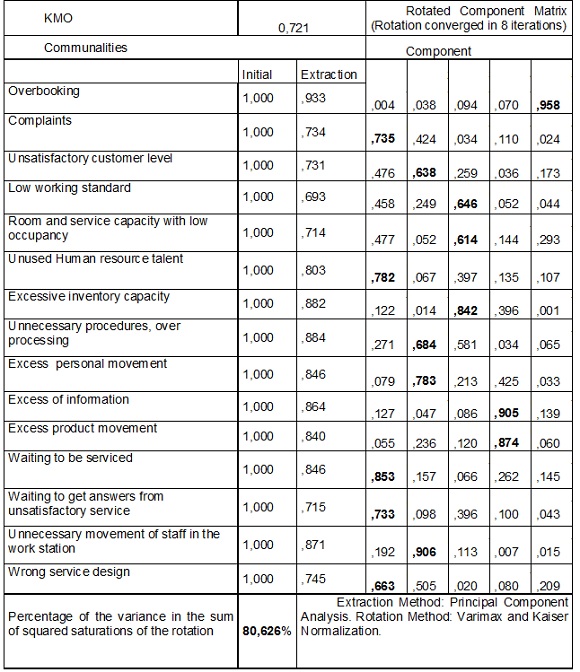
Source: Own Elaboration
Through the study of the communalities (variable defined as the proportion of variances that can be explained by the factor model obtained) of the extraction, it becomes evident that the variable corresponding to the inadequacy of the standards of work is the one worse explained: the model can only reproduce a 69.3% of its original variance. Table 2 shows the result of the factor analysis, as well as the component matrix, where the method of main components is used as method of extraction. All of this is aimed at detecting the variables that best explain the total variance existing in the wastes of tourism businesses as a basis to the consideration of five factors that explain 80.626% of the total variation
As shown in the projection of the units of analysis over the two dimensional factor plane in figure 1, the relation between variables and their convergency on the same quadrant results evident, which shows the relations existing between the different types of wastes, standing out the fifth component as the waste less related to the others.
Figure 1. Two dimensional factor plane (Space rotated Component graphic)
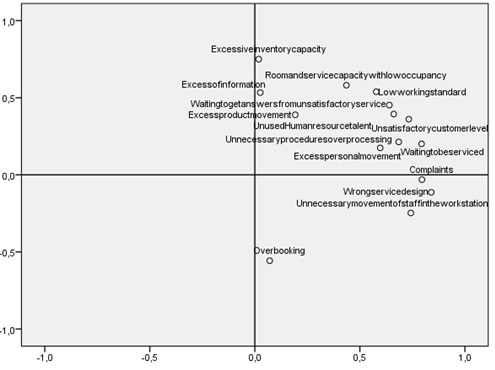
Source: Own Elaboration
The convergency of five factors or components was noticed. These correspond to the following aspects:
Interrelation between waiting time for the client and poorly designed services: clients wait because services are poorly designed and the workforce is not efficiently used, which causes complaints.
Movement and reprocesses: to avoid reprocesses and to optimize the movement of people in their area and outside it in order to prevent unsatisfied customers.
Service capacity and inventories: inventories are correlated to the capacity of services.
To link the information and the product: to control the movement of the products and the flow of information.
Overbooking of hotels and to sale overcapacity of services.
Of the organizations visited, a 25% have less than 50 workers, 56% have between 50 and 200 and 19% have more than 200. Five travel agencies and 11 hotels where included in the study, 13% of them have less than 1 million of income, 63% have between 1 and 5 million and 25% more than 5 million CUC (Cuban Convertible Pesos) per year.
In the businesses where surveys were applied, 37.5% of these were made to the Sales Management, 25 % to the General Managers and 37.5 % to the Quality Department. Among the people surveyed, 38 % of them have been up to 3 years working in the tourist business, 25% between 4 and 10 years, while 38% of them have been more than 10 years.
According to the people surveyed, in 14 of the aforementioned businesses, changes have been implemented up to 87.5 %, another two the organizations keep working without any change and there is one new in the business. The other case studied is functioning with no visible change and here incomes and utilities remain the same, although the customers are decreasing.
After applying the tool (survey), it is clear that general quality management and costs saving are among the change initiatives most commonly implemented in these businesses, each of them representing the 23 % of all the changes developed. Nevertheless, their managers and specialists do not think of them as related to the lean initiative figure 2, this latter mentioned only twice in the surveys.
Figure 2. Change initiative
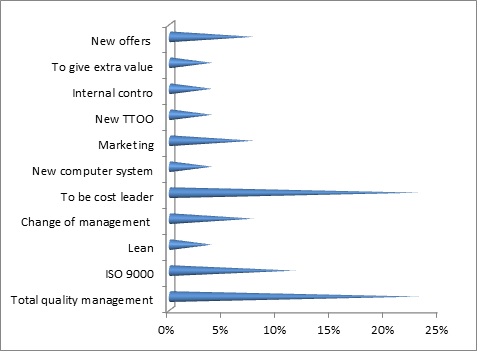
Source: Own Elaboration
Rather, the goals of the changes are perceived as related to costs saving, increasing customer’s satisfaction and incomes increase, all three representing the 56 % of the change goals, figure 3.
On the other hand, in all these businesses, the activities not adding value to the final customers are perceived by their managers, waste. When analyzing this latter, the main problems are related to the client’s wait, their complaints, unnecessary inventories and wrongly-designed processes, figure 4.
Figure 4. Average waste present in the installation
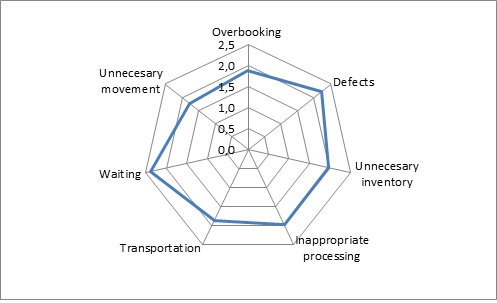
Source: Own Elaboration
When we observe what was expressed by those who were surveyed in the studied installation it is concluded that:
the amount of clients grows in 7 of them, remain the same in 6 and decrease in 3
Income increase in 9, remain the same in 4 and decrease in 3
Profits grow in 8, remain the same in 5 and decrease in 3
It was verified that the existence of waste is perceived in every installation, however, in those, which had a decreasing amount of clients, and income, this presence is even greater than in those that maintain or grow in regards to those indicators. Those with decreasing profits have the same behavior but with a smaller difference in perception. This result suggests the pertinence of deepening the relation between the presence of waste in tourism facilities and its relation with economic and financial results.
CONCLUSION
Five factors or components where obtained from the factor analysis, as opposed to the literature material regarding lean philosophy, which, since its start in the TPS and in the service industry, identifies seven(Chiarini, 2013; Hines, Found, Griffiths, & Harrison, 2011; Leite & Vieira, 2015; Navas & Machado, 2015; Sundar, Balaji, & Kumar, 2014). The advantage of using the factor analysis contained in this investigation is that it suggests an order of analysis and importance to consider in the hospitality industry. The authors consider wastes to have the following denominations:
Waiting time
Movement
Capacity
Traceability
Offer
The seven wastes present in the manufacturing industry also exist and are applicable to the hospitality industry; for their study and implementation in tourism, this investigation suggests to group said wastes in five components. Wastes exist in every facility studied, which facilitates the start of the implementation of lean philosophy in tourism.
The main initiatives of change of the facilities that are being studied in this article are related to cost reduction and total quality management. These initiatives of change create the proper conditions for the application of the lean philosophy in a tourism company.
The main objective of change of the facilities that are being studied in this article is the reduction of costs. This objective of change creates the proper conditions for the application of the lean philosophy in other locations, from waste finding to cost reduction and studying the relation between them.
From the initial observation, the authors identified a relation between factors such as amount of clients, income and utility with the amount of wastes of the facility; which indicates the convenience of investigating the relation existing between the presence of waste in tourism facilities and their financial results.
The relation found between the lean philosophy and the changes that occur in tourism suggests that it would be convenient to integrate lean philosophy in the change process models that are used to manage changes in tourism.
REFERENCES
Please refer to articles in Spanish Bibliography.
BIBLIOGRAPHCIAL ABSTRACT
Please refer to articles Spanish Biographical abstract.